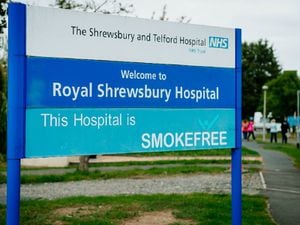Region has highest neonatal mortality rate in England and Wales
Neonatal mortality rates are higher in Shropshire, Staffordshire and the Black Country than anywhere else in England and Wales, a new report has found.

The annual National Neonatal Audit Programme (NNAP) measured mortality in very premature babies, those born at 24 to 31 weeks gestation, at neonatal networks between 2015 and 2018.
Among them was the Staffordshire, Shropshire and Black Country Neonatal Operational Delivery Network (ODN), which included the neonatal unit at the Shropshire Women and Children’s Centre in Telford. The network merged with another earlier this year.
Staffordshire, Shropshire and the Black Country had the highest mortality rate for very premature babies in England and Wales, at 9.8 per cent. That is twice the lowest rate in England and Wales, 4.9 per cent at North Central & North East London.
The average across England and Wales is 6.8 per cent.
The NNAP's report included data for the 1,082 babies born in the Staffordshire, Shropshire and Black Country ODN at 24 to 31 weeks gestation between July 2015 and June 2018.
It found that 107 of them died before being discharged home or 44 weeks after birth, whichever occurred sooner. After adjustment, the mortality rate was found to be 9.8 per cent.
The Staffordshire, Shropshire and Black Country ODN included Princess Royal Hospital Telford, Royal Stoke University Hospital, Manor Hospital Walsall, Birmingham City Hospital, New Cross Hospital Wolverhampton and Russells Hall Hospital Dudley.
Earlier this year it merged with the Southern West Midlands network to form the West Midlands Neonatal ODN.
A charity called for neonatal networks to improve "without delay" but also urged the Government to act quickly in making sure care is sufficiently resourced.
The report contained recommendations for reducing mortality in very premature babies. They include to consider a review of network structure and practices, as well as "evidence-based strategies".
Staffing
The report also found that less than half of the neonatal unit shifts in Staffordshire, Shropshire and the Black Country are staffed with the nationally recommended number of nurses.
Just 42.8 of neonatal shifts are numerically staffed according to national guidelines while 32.3 per cent of neonatal shifts have the recommended number of nurses ‘qualified in speciality’ to care for the babies on the unit.
The figures across Britain are 64 per cent and 44 per cent respectively.
To have a sufficient number of nurses on all shifts, the Staffordshire, Shropshire and the Black Country ODN would need its nursing staff to work an additional 4,963 shifts.
Justin Irwin, chief executive of the premature and sick baby charity Bliss, said: “It’s deeply concerning to see unwarranted variation in neonatal mortality between different neonatal networks.
“The death of a baby has a devastating impact on the families behind these statistics and we encourage networks to implement the recommendations in the NNAP report without delay.
“However, this must be underpinned by swift action from the Government to ensure neonatal care is sufficiently resourced so that all pre-term or sick babies receive the expert care they need. This is vital for every baby to have the best chance of survival and quality of life.”
Positives
The NNAP did find a number of metrics in which the Princess Royal Hospital outperformed the national average.
The national rate for babies born at less than 32 weeks gestation who had an appropriate temperature – between 36.5C and 37.5C – on admission to the neonatal unit was 67 per cent.
At the Princess Royal Hospital, this figure was 83 per cent.
The national proportion of admissions where parents were present on at least one consultant ward round during a baby’s stay was 79 per cent while in Telford that happened 100 per cent of the time.
The West Midlands Neonatal ODN and the Shropshire and Telford Hospital NHS Trust were approached for comment.





